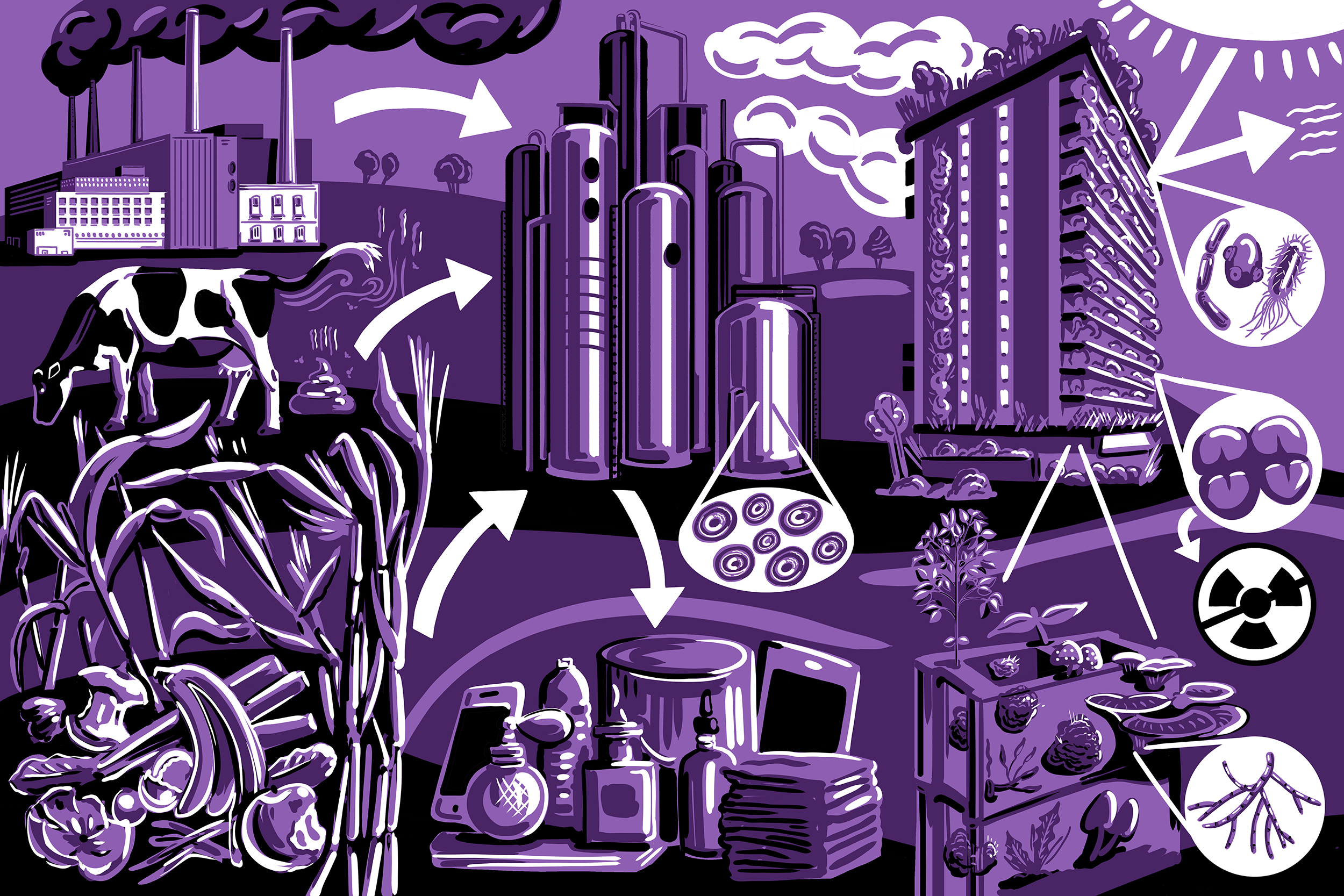Engineering Biology for Climate & Sustainability
Materials Production & Industrial Processes
Materials Production & Industrial Processes identifies engineering biology opportunities in the built environment, textiles, and other consumer products for reducing the anthropogenic carbon footprint, reducing toxins and wastes, and recovering economically-valuable resources sustainably.
Introduction
The manufacturing of materials and products, including plastics, textiles, cement and other building materials consumes large amounts of energy and is a substantial source of global greenhouse gas (GHG) emissions., This roadmap’s Materials Production & Industrial Processes theme focuses on how to replace some of today’s most energy-, resource-, and emissions-intensive — and environmentally-damaging — materials with sustainable, biobased alternatives. One important approach is to embrace a circular bioeconomy: the current global economy is largely linear, meaning that consumables are mass produced, used, and then disposed of; in a circular economy, products at the end of their life cycles become the inputs for a new generation of materials or products. Utilizing engineering biology to degrade materials and waste and recycle their components and generate new, value-added products will help build opportunities for decreasing the emissions associated with industrial processes and taking an important step toward a sustainable future.

Engineering biology for materials production and industrial processes. Engineering biology can not only be used to create new material products such as coatings or packaging materials, but can also help to replace or increase recycling of existing materials, such as through the incorporation of biodegradable polymers. One of the most alluring attractions to biomaterials is the capacity for self-renewal or self-repair. Take, for example, bioconcrete: not only could this replace the carbon-intensive production of concrete we currently use, but dynamic biological activity could be imbued to enable self-healing repair of cracks or stress-damage. Engineered enzymes and organisms can be used to recycle materials and accelerate the processing of – or even eliminate – waste streams. Biomanufacturing and bioprocessing can help to produce fewer environmentally-damaging or -toxic materials like plastic polymers and textile dyes. Further, engineering biology has the potential to enable greater resource recovery, such as the extraction of valuable minerals and metals from waste streams or production of numerous commodity chemicals from a single biofermentation process. Advancements will be needed in engineering enzymes, predicting and designing biomaterial dynamics, and engineering persistence and containment of engineered organisms or biosystems in open and semi-open environments.
Some industrial processes, such as the production of building materials, are especially challenging to decarbonize. This roadmap identifies ways in which engineering biology can facilitate the production of sustainable building materials, reducing the amount of embodied carbon in the built environment. Cement production, iron and steel production, and chemical manufacturing are the three highest CO2-emitting industrial sectors. These sectors are notoriously difficult to decarbonize because they rely on high-heat processes that cannot currently be electrified, and they also emit CO2 as part of the fundamental stoichiometry of the process. Opportunities for engineering biology include enabling low-carbon, self-repairing bioconcrete, engineering trees for the production of high-density wood for a larger variety of construction applications, and scaling up the production of sustainable biobased wall materials, such as mycelium-based thermal insulation.
This roadmap also aims to advance solutions in biobased alternatives to replace fossil fuel-derived plastics. Globally, around 400 million tons of plastic are produced every year, emitting GHGs at every stage of their production, and less than 10% of all plastics are subsequently recycled. Climate emissions reductions from bioplastics can be achieved primarily via two means: first, the carbon in bioplastics can be captured and fixed from the atmosphere, as opposed to being manufactured from fossil fuels; second, bioplastics can be produced with lower impacts (emissions), ensuring that the benefits of the biogenic carbon are realized. Additionally, bioplastics are much more likely to be fully degradable, helping to eliminate persistent waste, and accelerating recycling. Most bioplastics are used in packaging, but they are finding their way into everything from textiles to pharmaceuticals to electronics. Research continues to push the bounds of feedstocks, formulations, and applications. To address this, this roadmap highlights opportunities for replacing fossil fuel-derived plastics with bioplastics, improving the performance and cost of biobased packaging materials so that they may fully replace conventional plastic packaging, advancing biodegradation and bio-recycling processes, and advancing carbon-negative polymer and chemical manufacturing processes.
This roadmap also remarks on reducing the environmental footprint of the textile industry through engineering biology. It has been estimated that the textile industry is responsible for 8-10% of global GHG emissions, in addition to consuming massive amounts of water and generating chemical waste. There is the potential for engineering biology to enable textiles and dyes that are more affordable, sustainable, and better-performing than existing products. Opportunities include engineering organisms to produce long-lasting bio-pigments and scaling up the production of biomaterials like engineered spider silk and mycelium-based leather alternatives.
Finally, with the increasing production and use of electronics and the associated economic prioritization of products containing rare-earth elements, the capacity to recover these materials is becoming more and more important. This roadmap considers opportunities to use engineering biology to extract and purify metals and ores from natural environments, such as current mining sites, and for recovering minerals and metals from waste-streams. Adoption of such technologies has the potential to reduce the environmental damage associated with traditional mining, such as ecosystem disruption and the production of toxic waste streams, and provide more secure and sustainable supply chains.
Biomaterials in Engineering Biology & Materials Science
EBRC’s Materials Science & Engineering Biology: A Research Roadmap for Interdisciplinary Innovation, published in 2021, highlights tools, technologies, and processes for creating and enabling advanced materials using engineering biology. Engineering Biology & Materials Science contains technical milestones and achievements directly related to many of the goals found in this roadmap, including production of environmentally-friendly materials, such as bioconcrete, and sustainable manufacturing practices, including utilization of waste streams.
View →
